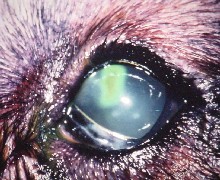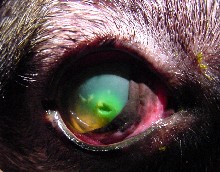Corneal Ulcers
What is a corneal ulcer? 
A corneal ulcer is an abrasion or a defect on the clear surface of the eye. They can vary from a few cells layers deep to nearly the full thickness of the cornea (see eye anatomy page). The cornea is not more than about 1 mm thick.
What causes a corneal ulcer?
Ulcers usually start with some sort of trauma to the eye such as a scratch, rub, abrasion or dry eye. A few ulcers have more unusual causes like a neurological problem or abnormal tissue causing the ulcer to take a long time to heal.
What are the signs of a cornea ulcer?
Ulcers can cause tearing, squinting, holding the eye closed, a bloodshot appearance (red eye), sensitivity to light and spasms of the eyelids.
How is a corneal ulcer diagnosed?
An ulcer is diagnosed during an eye exam by close inspection with a slit lamp biomicroscope and/or by fluorescein stain. This stain will not adhere to the normal surface of the eye but will appear green where the surface epithelium of the cornea is missing.
How quickly should a corneal ulcer heal?
A simple ulcer should heal in 3-7 days. Uncomplicated ulcers heal very quickly!
An infected or complicated ulcer can take several weeks to heal with proper treatment. Some deep, infected or large ulcers may need surgery to strengthen the eye for this long healing period. Blood vessels should grow into the cornea to heal an injured site. These grow at a rate of only 1 mm (1/25th of an inch) per day.
 What are the types of complicated ulcers? What are the types of complicated ulcers?
Infected ulcers - Either bacteria or fungus that normally live on the surface of the eye, skin and environment can infect a simple injury on the surface of the eye. These infections are very serious and can lead to the loss of the eye without aggressive medical treatment or surgery.
Indolent ulcer - Abnormal tissue or an underlying disease that causes the wound to heal slowly can result in an indolent ulcer. These often need a keratotomy procedure to allow them to heal. The most simple procedure is done with an awake animal and topical anesthesia although few ulcers may require surgery with general anesthesia. Any other diseases causing slow healing (diabetes, hypothyroidism, hyperadrenocorticism, etc) will also need to be managed for the ulcer to heal.
Neurogenic ulcer - Some neurological problems (inability to blink, inadequate eye sensation) can lead to corneal ulcers that heal abnormally.
Secondary ulcers - some ulcers form secondary to eyelid abnormalities, a foreign body, or "dry eye". These are managed with the underlying disease.
How are ulcers treated?
Simple ulcers are treated with topical antibiotics to prevent a secondary infection. Since the cornea has more nerves per square inch than an other area on the body, an Elizabethan collar may be necessary to keep animals from rubbing, scratching or bothering their eyes while they heal.
For infected ulcers, intensive antibiotics (medication every 1-2 hours) may be needed.
For any of the complicated ulcers, surgery may be indicated to heal the ulcer. Surgery on the cornea is usually done with an operating microscope. Surgery for indolent ulcers may be done on an awake or sedated animal using topical anesthesia only. Other surgery usually requires general anesthesia.
A therapeutic contact lens or eyelid flap may be necessary to protect the eye while healing.
|